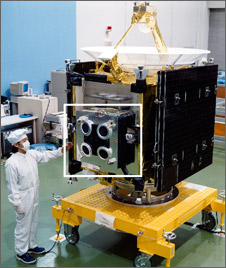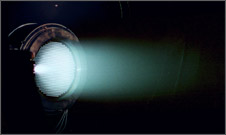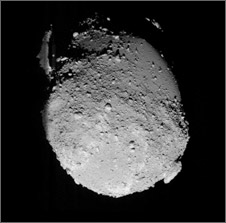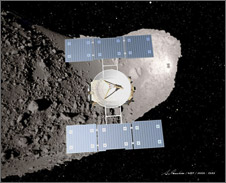

The major feature of Hayabusa's electric propulsion (ion) engines is the generation of plasma using microwaves. Propulsion is achieved by accelerating ionized propellant - xenon gas - through a strong electric field, and expelling it at high speed. Although this type of propulsion provides less power than chemical propulsion engines, which use the combustion of fuel and an oxidizer, electric propulsion engines have very high fuel efficiency, and can maintain acceleration for a long time. The lifespan of these engines has been extended to three times that of conventional ones by making the accelerating electrode plates of the ion engines out of a carbon-carbon composite material, which has excellent durability. The Hayabusa project was the first ever test of the ion engine in a practical situation.
Q. What was the main challenge in developing Hayabusa's ion engines?

Four ion engines installed on Hayabusa

Ion engine firing during ground test
They are a new system, so it was very difficult to create each part using existing technologies. The successful development of ion engines depended on creating materials that would last through 14,000 hours of operation in space, as it takes a few years to make a return flight between Earth and an asteroid. So we needed to demonstrate that the engines could operate over an extended period of time, and we conducted two 18,000-hour endurance tests. There are about 9,000 hours in a year, which means one test takes two years. The engines were placed in a vacuum for endurance tests conducted by a completely automated operation system, which was also challenging to build. It was stressful at the beginning because a simple programming error could have shut down the system in the middle of operation and aborted the test. In the early days, I even slept in the laboratory for months because I was afraid the computer might stop. Whether it was a Sunday or midnight, I occasionally hurried to the laboratory when I got a call that something seemed unusual with the equipment. Such a long test meant we went without New Year's or summer holidays. When the first endurance test was finally completed in 1999, it was such a joyful moment.
The successful completion of two 18,000-hour endurance tests gave us a lot of confidence. However, the space environment is very different from a man-made vacuum system. We have confidence in Hayabusa's ion engine system, but its durability in space is still not certain. We have equipped the spacecraft with the system in order to test it, so I see what happens every day as a new discovery for us.
Q. Hayabusa successfully performed an Earth swing-by maneuver in May 2004, a year after launch. How was this swing-by different from a conventional one?
The Hayabusa flight was the first time we attempted an orbit transfer using for acceleration from a combination of an Earth swing-by and ion engine propulsion. An ion engine has very high efficiency, but the power of its propulsion is limited, so an orbit transfer would take a long time. However, a long acceleration period results in the gradual stretching of the spacecraft's orbit. That means it travels farther from the Sun, and picks up less of the Sun’s energy, so its solar paddles cannot generate sufficient electricity to continue acceleration. This is why we decided on the combination of the ion engine and an Earth swing-by. In the first year after launch, we used the ion engines to accelerate the spacecraft in a direction that would keep it close enough to the Sun that it could acquire sufficient electricity from sunlight.

An image of the Earth taken by Hayabusa
The orbit transfer to the designated asteroid was performed by first accumulating speed using the ion engines, powered with electricity generated by the solar panels. Then we doubled Hayabusa’s speed using the swing-by technique. To carry out an accurate swing-by, the orbit has to be set extremely precisely. We accomplished this on May 19, but we had started guiding the spacecraft to the swing-by point about two months prior. I was relieved when the swing-by succeeded, but at the same time I was preoccupied with the operations that needed to be performed after the event. There is less electric power available as the spacecraft gets farther away from the Sun, so you have to have a new operation method. Frankly speaking, I was nervous about these challenging operations.
Q. What do you remember most vividly among Hayabusa’s operations thus far?
The most impressive moment for me was when the surface of Itokawa came into clear sight as Hayabusa approached the asteroid. I had worked so hard on developing the ion engine because I wanted to see a world I had never seen before. I truly understood what this meant when I saw Itokawa for the first time. The touchdown on Itokawa was also memorable, but ion engines weren't used after arrival at the asteroid, so there wasn't much for our group to do. I was just watching the scene, hoping that Hayabusa would land and take off safely, and return to Earth soon.
Q. What have you learned through the Hayabusa mission?
Technical development doesn't always go as you wish. There were times I almost felt defeated and wondered about waving the white flag. But I was able to complete the technology with a last-minute effort, knowing that, if I gave up, an original engine system created in Japan wouldn't be born.
Missions don't always go as smoothly as planned. Hayabusa has overcome many obstacles. In that sense, I feel I raised Hayabusa's ion engines little by little, almost like a newborn baby, by calming and cheering them on. I am determined not to give up until the end.
Q. What does Hayabusa mean to you?

Asteroid Itokawa
The Hayabusa mission was my ambition. I have been working on ion-engine research since the 1980s. The Hayabusa project didn't exist back then, but knowing the characteristics of ion engines, I was sure they would one day be used for exploring small bodies such as asteroids and comets. And in the 1990s, when the Hayabusa project was approved, I really wanted to install ion engines on the spacecraft. As far as developing the technology, we had a strong desire to contribute to Japanese scientific exploration with our own original technology, instead of copying other countries. So we worked on development of a microwave discharge ion engine, which was an absolutely new system at the time. As the deadline approached, there were moments when we thought we might not make it in time. But I am very proud that we were able to build the technology in time for Hayabusa, and its four ion engines have set a record of 26,000 hours of operation and counting.
Q. What is your dream?
What we have done with Hayabusa is about flight dynamics in deep space. The initial speed is given to a conventional explorer by a large-scale rocket, and inertial navigation is used later. However, Hayabusa, equipped with high-performance engines, is capable of generating sustained propulsion and performing an orbit transfer on its own. With this technology, I'd like to develop a new space transportation system between Earth and deep space.
Q. Do you have a message for children who wish to be part of space development in the future?
I believe that the evolution of technology changes our world view. For example, the Soviet astronaut Yuri Gagarin, who in 1961 became the first human in space, is said to have commented that the Earth was blue. It might have been the moment when the Earth was recognized for the first time as a unique oasis in the pitch dark of the universe. I think Hayabusa will bring a new view of the cosmos to science. The evolution of technology is aimed not only at space but also at many other areas, such as the bottom of the ocean, the microscopic world, and inner biology. I'd like young people to expand the frontiers of human intelligence and activity.
Q. What do you think about Hayabusa's return?
Everything since launch has been a new experience for me, but the spacecraft, which is on its way back to Earth, is now in a condition we could not have imagined at launch. After Hayabusa had trouble with much of its equipment around its arrival at Itokawa, the only devices that are usable for the return trip are a momentum wheel for attitude control, and the ion engines.

Asteroid explorer Hayabusa (Itokawa in real image, and Hayabusa in a CG montage)
On top of these few devices, we came up with a new attitude control maneuver using sunlight pressure, and have been testing the ion engines since this March. Hayabusa finally left Itokawa's orbit in mid-April, and now we'll do our best to bring it safely back to Earth. This new control method also has the potential to be applied in controlling the attitude and orbit of the solar-powered sail, which is our next target for actualization. So, in that sense, we are very lucky to have a chance to work on this new engineering agenda. If Hayabusa, on ion engines, comes back safely, and the asteroid sample return capsule is successfully retrieved on Earth, the accomplishment will be significant not only in the engineering sense but also for science. So I'd like to bring Hayabusa back home by trying to make the ion engines work in space as long as possible. I believe in the potential of the ion engines.
Doctor of Engineering. Professor at the Department of Space Transportation, the Institute of Space and Astronautical Science (ISAS)/JAXA.
In 1988, Dr. Kuninaka graduated from the Department of Aeronautics and Astronautics at the University of Tokyo, and got a position at ISAS. He has been in his current position since 2005, and is also a professor of the Department of Aeronautics and Astronautics, Graduate School of Engineering, at the University of Tokyo. Dr. Kuninaka specializes in electric propulsion and plasma engineering.







